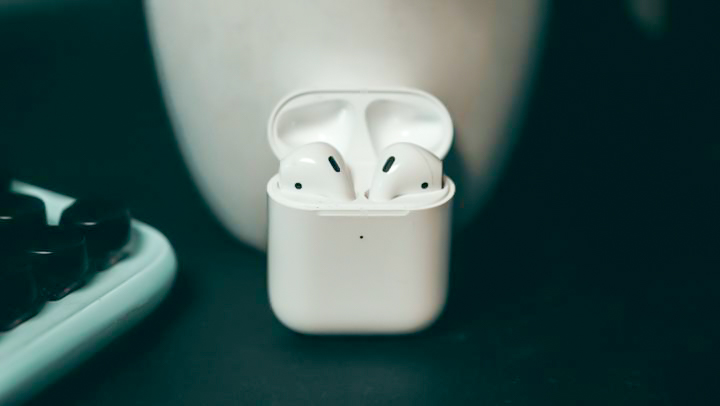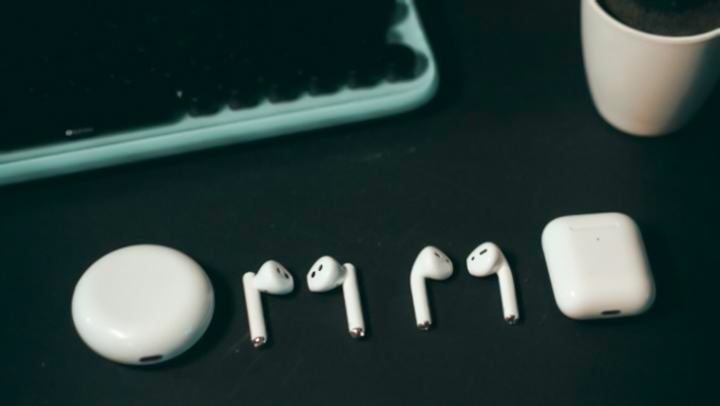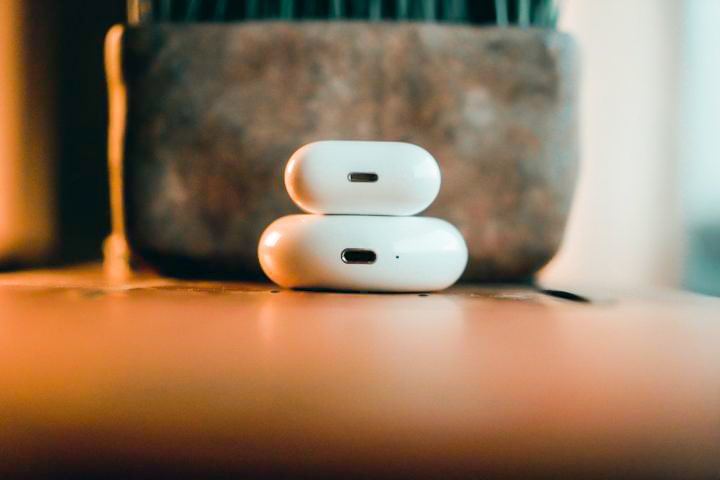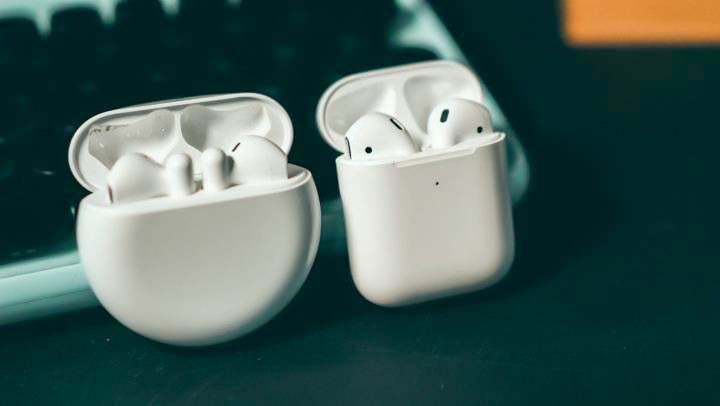True Wireless Stereo Earphones have been on the rise recently, as the non-inclusion of 3.5mm headphone jacks in devices have become more common. Apart from the basic music-listening features, several wireless earphones these days offer several aspects that make them stand out from the rest. For this comparison, we’re looking at the Huawei FreeBuds 3 and the Apple AirPods 2. Which true wireless earbuds can give you more features for its price tag? Read on and find out.
Table of Contents

Let’s start by comparing the cases of the FreeBuds 3 and the AirPods 2. The FreeBuds 3 come in a circular carrying case. On the other hand, the AirPods 2’s case has a rounded-square shape to it and is slightly smaller than the FreeBuds 3’s case.

The two cases are lightweight, easy to carry, and smooth to the touch. Both have a magnetic top cap that can be easily opened and closed with one hand. The earbud slots of both cases are also magnetic, allowing both the FreeBuds 3 and AirPods 2 to snap in place in their respective cases.

Both cases feature a pairing button, with the button located on the rear of the AirPods 2’s case, while the FreeBuds 3 has it on the right side. Down below, the FreeBuds 3 and the AirPods 2 have a USB-C charging port and a Lightning port, respectively. As for the cases’ charging indicators, the AirPods 2 have it on the front of the case, while the FreeBuds 3’s placed its indicator next to the USB-C port. The FreeBuds 3 also have a charge indicator for the buds themselves; one can see it right away upon flipping open the top cap.

Taking a look at the earbuds, the FreeBuds 3 and the AirPods 2have some slight similarities to them. They both feature long stems and have an open-air design. Notably, though, Huawei calls the FreeBuds 3’s look as a Dolphin Bionic design, allowing the buds to fit in more comfortably in the user’s ears. At the bottom, the FreeBuds 3 feature an Aerodynamic Mic Duct design that lessens wind noise, while the AirPods 2’s bottoms are open, with grilles covering them.
The FreeBuds are available in Carbon White and Ceramic Black, while Apple only offers the AirPods in white.

As both the FreeBuds 3 and AirPods 2 are wireless buds, they connect to devices via Bluetooth. The AirPods 2 comes with Bluetooth 5.0 connectivity, while the FreeBuds 3 have Bluetooth 5.1 connectivity.
Pairing either earbuds with devices is rather straightforward. For the FreeBuds 3, opening the cap of the case next to a smartphone will trigger a pop-up window, allowing users to pair the buds with their device easily. The instant pairing only works on devices that have EMUI 10 or above, though.

The AirPods 2’s instant pairing also works similarly. Opening the AirPods 2’s case next to an iOS device will trigger a pop-up window, and users can pair the buds with their device through that. However, this method only works on iOS devices that are updated to the latest version of iOS.
For those who don’t have EMUI 10 or the latest iOS update, both the FreeBuds 3 and the AirPods 2 can be connected manually. The AirPods 2 and the FreeBuds 3 are compatible with Android and iOS devices and can be set up quickly.

Manual pairing works similarly for both earbuds. One has to open the AirPods 2 case next to a device and press the pairing button located on the rear until the indicator light turns white. The FreeBuds 3 can also be synced with devices by opening the cap and pressing the pairing button located on the right side until the light indicator inside the case turns white.

The Huawei FreeBuds 3 are powered by a Kirin A1 chipset, giving the earbuds a host of features. One of the main highlights of the FreeBuds 3 is that they have active noise cancellation, allowing users to enjoy music even in loud environments. The A1 chipset equipped in the buds also eliminates background noise during calls and enhances the user’s voice. The FreeBuds 3 also have a bone sensor for clearer calls, low latency, have a 356MHz audio processor, and accurate video and audio synchronization.

The AirPods 2, on the other hand, have an Apple H1 chipset. It allows the AirPods 2 to access a voice-enabled Siri, deliver low gaming latency, and stable connections with the devices it’s synced. The AirPods 2’s H1 chip also comes with a speech-detecting accelerometer to filter out external noise and focus on the sound of your voice during calls.

Both the FreeBuds 3 and the AirPods 2 feature touch controls. For the FreeBuds 3, tapping on the right bud twice plays, pauses, and switches the music, while double-tapping the left bud will switch on/off the active noise-canceling function. While those are the standard controls, they can be modified via the Huawei AI Life app. Users can select which function they’d like to assign to either left or right bud.
As for the AirPods 2, tapping the right bud twice will play, pause, or switch the music, while the left bud doesn’t have any functions. Instead of a dedicated app to modify the controls, the AirPods 2 can be customized via the Bluetooth settings in iOS devices. Though that, users can then assign either Siri, play/pause music, skip/return tracks, or none at all.
For battery life, the FreeBuds 3 have 30mAh on each earbud, while the charging case comes equipped with 410mAh. The FreeBuds 3 has about 4 hours of playback on a single charge, and up to 20 hours of playback when used with the charging case. It is also capable of charging it up to 45% battery in just 15 minutes.

On the other hand, while Apple didn’t disclose the battery capacity of the AirPods 2, it has up to 5 hours of listening time and up to 24 hours of listening time with its charging case. Apple also noted that the AirPods have up to 3 hours of talk time. Charging will give you 15% power in 15 minutes.

When it comes to charging, the FreeBuds 3 can be charged via the USB-C port located on the bottom of its case, while the AirPods 2’s case has a Lightning port. The FreeBuds 3 case already offers wireless charging, in contrast to the AirPods 2 that only comes with a standard charging case. Apple provides a wireless charging case option, though, for an additional price.

For pricing, Huawei offers the FreeBuds 3 with a tag of PHP 8,990USD 153INR 12,987EUR 146CNY 1,116. On the other hand, the Apple AirPods 2 are priced at PHP 9,490USD 162INR 13,709EUR 154CNY 1,178. If users would like to have a wireless charging case with their AirPods, it will set them back PHP 11,790USD 201INR 17,032EUR 191CNY 1,463.

Both the FreeBuds 3 and AirPods 2 offer a premium design, instant pairing, are easy to set up, and have pretty good battery life. If you’re heavily invested in the Apple ecosystem, I think you’re better off with the AirPods 2. However, the FreeBuds 3 does edge out the AirPods 2 when it comes to features and pricing. For its price tag, the FreeBuds 3 already has active noise-cancellation, a wireless charging case, and two color options. If you’re looking for a premium true wireless earbuds that offer several features, the FreeBuds 3 is the perfect earbuds for you.
Huawei has an ongoing promo where you will receive PHP 2,000USD 34INR 2,889EUR 32CNY 248 discount on the FreeBuds 3 for customers who purchase the Huawei Mate 30, Mate 30 Pro, P30, P30 Pro, of Nova 5T from November 30 to January 5. The promo is available on these Huawei retail stores for cash payment, credit card, or Home Credit (up to 6 months installment).

YugaTech.com is the largest and longest-running technology site in the Philippines. Originally established in October 2002, the site was transformed into a full-fledged technology platform in 2005.
How to transfer, withdraw money from PayPal to GCash
Prices of Starlink satellite in the Philippines
Install Google GBox to Huawei smartphones
Pag-IBIG MP2 online application
How to check PhilHealth contributions online
How to find your SIM card serial number
Globe, PLDT, Converge, Sky: Unli fiber internet plans compared
10 biggest games in the Google Play Store
LTO periodic medical exam for 10-year licenses
Netflix codes to unlock hidden TV shows, movies
Apple, Asus, Cherry Mobile, Huawei, LG, Nokia, Oppo, Samsung, Sony, Vivo, Xiaomi, Lenovo, Infinix Mobile, Pocophone, Honor, iPhone, OnePlus, Tecno, Realme, HTC, Gionee, Kata, IQ00, Redmi, Razer, CloudFone, Motorola, Panasonic, TCL, Wiko
Best Android smartphones between PHP 20,000 - 25,000
Smartphones under PHP 10,000 in the Philippines
Smartphones under PHP 12K Philippines
Best smartphones for kids under PHP 7,000
Smartphones under PHP 15,000 in the Philippines
Best Android smartphones between PHP 15,000 - 20,000
Smartphones under PHP 20,000 in the Philippines
Most affordable 5G phones in the Philippines under PHP 20K
5G smartphones in the Philippines under PHP 16K
Smartphone pricelist Philippines 2024
Smartphone pricelist Philippines 2023
Smartphone pricelist Philippines 2022
Smartphone pricelist Philippines 2021
Smartphone pricelist Philippines 2020
Totyo says:
How about sound quality? Sheesh
Jony ive says:
Bang for the buck….